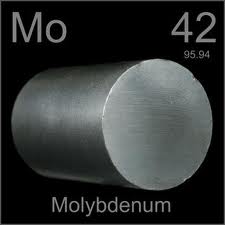Molybdenum Powder
Product performances turbines and nozzle, etc.
History of Molybdenum
Molybdenum was first discovered in 1778 by a Swedish chemist named Carl William Scheele. Though Scheele is credited with the discovery of molybdenum in its elemental (oxide) form, it was Peter Hjelm who in 1782 first reduced the oxide with carbon to produced the gray metallic powder which he also named molybdenum.
In early 1900's. Industrial and Military applications required stronger steels with greater resistance to corrosion and damage.It was found that molybdenum could impart an impact resistance similar to tungsten when alloyed with steel, with less weight. Demand for molybdenum initiated an intensive search for new sources to insure a reliable supply. In addition to primary molybdenum mines, molybdenum is also recovered as a byproduct of copper and tungsten mining operations. The metal is produced from purified ammonium molybdate or molybdic trioxide powder through hydrogen reduction at high temperatures.
Characteristics of Molybdenum
 Molybdenum is a transition metal. In its pure form, it is a soft, silvery white metal which has one of the highest melting points (2,623 °C/4,753 °F) of all elements. Though it has the fifth highest melting point of all of the elements, it has the lowest coefficient of thermal expansion, making it a highly sought after component in high temperature applications.
Molybdenum is a transition metal. In its pure form, it is a soft, silvery white metal which has one of the highest melting points (2,623 °C/4,753 °F) of all elements. Though it has the fifth highest melting point of all of the elements, it has the lowest coefficient of thermal expansion, making it a highly sought after component in high temperature applications.
Molybdenum oxidizes readily at temperatures in excess of 760°C. When exposed to air at this temperature, an oxide layer sublimes as the base metal reacts with oxygen, resulting in an oxidation process that resembles smoke. When properly controlled, the oxide can be recovered and reduced again to reclaim its molybdenum content. To avoid oxidation loss however, molybdenum is often utilized in inert or vacuum environments.
The largest use of molybdenum is as an alloy in the production of steel and stainless steel. Ultra high strength steels with up to 8% contained molybdenum can withstand pressures up to 300,000 pounds per square inch. It also improves the strength of steel at elevated temperatures. In alloy applications, molybdenum content varies from 0.5% to 8%, dependent upon desired characteristics. Overall, iron and steel account for more that 78% of the worlds molybdenum consumption.
Typical Chemical Analysis of Molybdenum powder:
Element |
Wt% |
|
Al |
0.002 |
|
C |
0.007 |
|
Cr |
0.0025 |
|
Cu |
0.002 |
|
Fe |
0.01 |
|
Ni |
0.004 |
|
W |
0.03 |
|
Co |
0.002 |
|
Mg |
0.001 |
|
Mn |
0.001 |
|
O2 |
Medium |
Coarse |
0.15 |
0.08 |
|
Mo |
99.95 Minimum excluding gases |
|
Typical Physical Properties of Molybdenum powder:
|
Medium* |
Coarse* |
||
Average Particle Size by Fisher Sub-Sieve Sizer |
||||
FSSS as Supplied |
2.0 – 3.5 |
3.5 – 6.0 |
||
Porosity as Supplied |
>0.60 |
>0.60 |
||
Scott Density g/In3 |
12 – 25 |
15 – 30 |
||
Tap Density g/cc |
1.9 – 3.5 |
2.0 – 4.0 |
||
Mesh Analysis |
>150 |
0–2% |
>150 |
0–2% |
<150 |
98% Min |
<150 |
98% Min |
|
If you have any interest in molybdenum powder, please feel free to contact us by email: sales@chinatungsten.com or by telephone:+86 592 5129696.
More info>>
